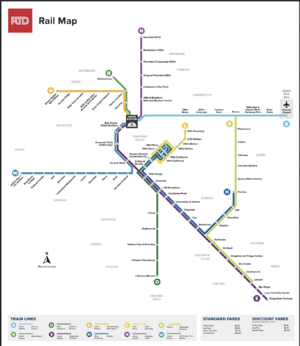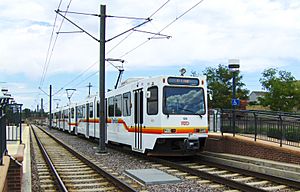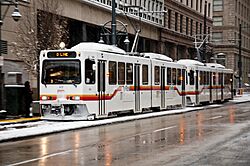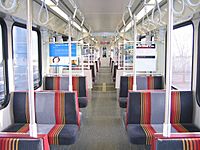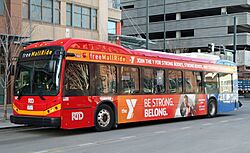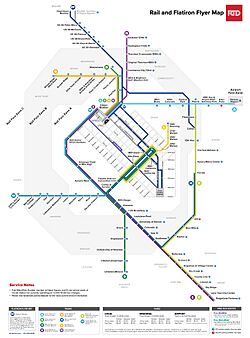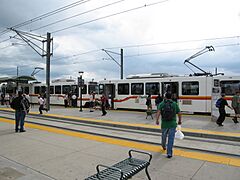Regional Transportation District facts for kids
Quick facts for kids RTD |
|||
|---|---|---|---|
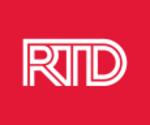 |
|||
| Info | |||
| Owner | Regional Transportation District | ||
| Locale | Denver Metro Area, Colorado | ||
| Transit type | Bus Commuter rail Light rail |
||
| Number of lines | 127 (Bus) 4 (Commuter rail) 6 (Light rail) |
||
| Number of stations | 57 (Light rail) 22 (Commuter rail) |
||
| Chief executive | Debra Johnson | ||
| Headquarters | 1660 Blake Street Denver, Colorado |
||
| Operation | |||
| Began operation | 1969 (Bus) 1994 (Light rail) 2016 (Commuter rail) |
||
| Reporting marks | RTDC, RTDZ | ||
| Number of vehicles | 1,026 (Bus) 267 (Rail) |
||
| Technical | |||
| System length | 113.1 mi (182.0 km) (60.1 mi (96.7 km) light rail, 53 mi (85 km) commuter rail) | ||
| Track gauge | 4 ft 8 1⁄2 in (1,435 mm) standard gauge | ||
| Electrification | Overhead line, 750 V DC (light rail) or 25 kV 60 Hz AC (commuter rail) | ||
|
|||
The Regional Transportation District, or RTD, is a public agency that runs buses and trains in the Denver Metro Area in Colorado. It serves eight counties, covering a large area of 2,342-square-mile (6,070 km2). About 3.08 million people live in this area.
RTD started in 1969. It is managed by a board of 15 members who are elected by the public. Each director serves for four years and represents about 180,000 people.
Today, RTD operates a big system of buses and trains. It has 86 local, 23 regional, and 14 limited bus routes. There are also 3 special SkyRide bus routes. The rail system includes 6 light rail lines and 4 commuter rail lines. These lines have 77 stations and 113.1 miles (182.0 km) of track.
In 2022, many people used RTD services. On average, about 238,500 people rode RTD each weekday as of the first quarter of 2023. RTD employs 2,888 people. It had a budget of $675.5 million in 2018. You can find RTD schedules on Google's trip planner. There are also mobile apps for phones that help you plan your trips.
RTD is currently building a big expansion project called FasTracks. This project will add 122 miles (196 km) of new rail lines. It will also add 18 miles (29 km) of fast bus routes. Plus, 21,000 new parking spaces will be built at stations. This will make bus service even better across the eight counties.
Contents
How RTD Started and Grew
Bus Services Over Time
Bus service in Denver began in 1924. The first bus ran between Englewood and Fort Logan. By 1950, buses had replaced all the old streetcars in the Denver area. The Denver Tramway Company, a private company, ran these buses.
In 1969, the state of Colorado created RTD. Its goal was to provide public transportation to more counties around Denver. RTD started taking over bus services from private companies. It made bus services more frequent and added new routes.
In 1973, people voted to add a small sales tax to support RTD. This tax helped pay for more bus services. It also planned for a new type of transit system, but that project was later stopped. The tax rate changed over the years, increasing to 1.0% in 2005.
By 1974, RTD had bought all the local bus systems. This included Denver Metro Transit and the bus system in Boulder. RTD also bought companies that ran airport buses.
In the mid-1970s, RTD made its services better. It added more routes and ran buses more often. In 1978, RTD changed all its bus routes. Instead of routes mostly going to downtown, they used a new grid system. This made it easier to understand the routes.
In 1980, RTD had a record number of daily passengers. It also added more Park-n-Ride locations. These are places where you can park your car and then take a bus or train. RTD also made its services easier for elderly and disabled people to use.
In 1994, special lanes for buses and carpools opened on I-25. These lanes helped buses move faster.
The 16th Street Mall in downtown Denver was approved in 1979. This area was designed for buses and people walking. It helped express buses move more efficiently. RTD's first light rail line later crossed this mall.
In 2014, RTD's Market Street Station closed. The new Union Station replaced it. A free bus service called Free MetroRide started. It connects Union Station to Civic Center Station.
The Start of Light Rail
RTD started planning for light rail in the mid-1980s. Other cities were building light rail systems, and they were successful.
RTD's first light rail line opened on October 7, 1994. It was called the Central Corridor. This line was 5.3-mile (8.5 km) long. It ran between the 30th & Downing and I-25 & Broadway stations. Over 200,000 people rode the new system during its first weekend.
More light rail lines opened over the years:
- The Southwest Corridor opened in July 2000. It extended the line to Mineral Avenue in Littleton.
- The Central Platte Valley spur opened in April 2002. This line went to Denver Union Station.
- In 2003, part of the downtown line was moved because of construction for the Colorado Convention Center.
In April 2006, some transit workers went on strike. They were unhappy about health care costs and working hours. The strike lasted seven days. It caused some delays for commuters, but many found other ways to travel.
The Southeast Corridor opened in November 2006. This line was 19-mile (31 km) long. It ran along I-25 and I-225. The West Rail Line opened on April 26, 2013. By then, RTD had 170 light rail vehicles. They ran on 47 miles (76 km) of track.

The light rail R Line opened on February 24, 2017. It connects Aurora and Lone Tree.
During the COVID-19 pandemic, RTD changed some services. Some bus and light rail lines were stopped. Two light rail lines, the F and C lines, were permanently closed in 2023.
The Rise of Commuter Rail
In 2004, voters approved the FasTracks project. This led to plans for new commuter rail lines.
The first commuter rail line, the A Line, opened on April 22, 2016. It connects Denver Union Station to Denver International Airport. The second line, the first part of the B Line, opened on July 25, 2016.
These new commuter rail systems use advanced technology for safety. This includes a system called Positive Train Control (PTC). After the A Line opened, it had some issues with its power system and crossing signals. RTD worked to fix these problems. The G Line to Wheat Ridge opened on April 26, 2019.
Train Accidents and Incidents
On January 28, 2019, an R Line light rail train went off its tracks. This happened because the train was going too fast around a curve. One person was seriously injured, and eight others were hurt.
Another derailment happened at the same spot on September 21, 2022. Three people were taken to the hospital with injuries that were not life-threatening. The cause of this accident was still being investigated.
What Services RTD Offers Now
Main Bus and Rail Services
RTD's main services are its scheduled bus and rail routes.
Most bus routes are either "Local" or "Regional."
Rail services have two fare zones: "local" and "airport." Local and regional bus and rail travel is within the local zone. The airport zone is for trips to and from Denver International Airport.
Rail Lines You Can Ride
Here are the current commuter rail lines:
| Line | Opening | Length | Stations | Ends At | |
|---|---|---|---|---|---|
| A A Line | April 22, 2016 | 23.5 mi (37.8 km) | 8 | Union Station | Denver Airport |
| B B Line | July 25, 2016 | 6.2 mi (10.0 km) | 4 | Union Station | Westminster |
| G G Line | April 26, 2019 | 11.2 mi (18.0 km) | 8 | Union Station | Wheat Ridge/Ward |
| N N Line | September 21, 2020 | 13 mi (21 km) | 7 | Union Station | Eastlake/124th |
Here are the current light rail lines:
| Line | Opening | Stations | Ends At | |
|---|---|---|---|---|
| D D Line | October 7, 1994 | 12 | 18th & California | Littleton–Mineral |
| E E Line | November 17, 2006 | 21 | Union Station | RidgeGate Parkway |
| H H Line | November 17, 2006 | 16 | 18th & California | Florida |
| L L Line | January 14, 2018 | 6 | 16th & California/Stout | 30th & Downing |
| R R Line | February 24, 2017 | 19 | Peoria | RidgeGate Parkway |
| W W Line | April 26, 2013 | 15 | Jefferson County Government Center–Golden | Union Station |
Special Bus Services
RTD offers special bus services for different needs:
- Access-a-Ride: This service helps people with disabilities who cannot use regular buses and trains.
- FlexRide: This is an on-demand shuttle service. It connects areas with less public transport to nearby train or bus stations.
- Flatiron Flyer: This is a fast bus service between Boulder and Denver.
- Free MallRide: A free shuttle bus that runs along the 16th Street Mall. It connects three main RTD stations.
- Free MetroRide: Another free shuttle. It runs faster than the MallRide on 18th and 19th Streets.
- SeniorRide: Shuttles for groups of 10 or more seniors. It also offers scheduled trips between shopping centers and senior living places.
- SkyRide: An express bus service for travelers going to Denver International Airport.
- Sporting Events Service:
- "BroncosRide" takes fans directly to Broncos Stadium at Mile High.
- "RunRide" takes people to Boulder for the Bolder Boulder 10K race.
RTD Stations
Bus Stations
Major bus stations are where express and regional bus routes end. Many local routes also stop nearby. This makes it easy to switch between different bus lines. Of the three main bus stations, only Union Station also has light rail trains. None of these main stations are Park-n-Ride facilities. Civic Center Station is linked to Union Station by the Free MallRide and Free MetroRide shuttles.
| Station Name | Address |
|---|---|
| Civic Center Station | 1550 Broadway, Denver |
| Union Station (rail and bus) | 1701 Wynkoop Street, Denver |
| Downtown Boulder Station | 1400 Walnut Street, Boulder |
Rail Stations
Many light rail and commuter rail stations also have bus stops. There are 77 stations in the RTD Rail system. RTD designs its stations carefully. They focus on the platform, the ticket area, and how people can access the station. Platforms are built for different train sizes. The ticket area is where you buy tickets and find passenger services. All stations also feature public art as part of RTD's "art-n-Transit" program.
Park-n-Ride Locations
Many rail stations and some bus stops have special parking lots. These are called Park-n-Ride locations. You can park your car there and then take public transport. RTD has 92 Park-n-Ride facilities. They offer more than 30,000 parking spaces.
RTD Vehicles

Most of RTD's buses are Gillig Low Floor models. They replaced older buses in the late 2000s. In 2014, RTD started getting new New Flyer Xcelsior buses. These are low-floor buses used for the Free MetroRide and other routes. MCI and Neoplan vehicles are used for express and regional buses. This includes the SkyRide service to Denver International Airport. In 2016, RTD began using 36 BYD K10MR all-electric buses for the 16th Street Mall.
For light rail, RTD uses Siemens SD-100 and SD-160 vehicles. As of May 2015, RTD had 172 light rail vehicles. For its new commuter rail system, RTD uses Silverliner V trains.
Here is RTD's current rail fleet:
| Model | Year Started Service | Type | Number |
|---|---|---|---|
| Siemens SD-100 Cars | 1994 | Light rail | 49 |
| Siemens SD-160 Cars | 2006 | Light rail | 123 |
| Silverliner V Cars | 2016 | Commuter rail | 66 |
How to Pay for RTD Rides
RTD's fares depend on how far you travel. For rail, it's based on zones. For buses, it's based on the service level.
Since 2024, a local bus ride or a trip on the rail costs $2.75. A trip to or from Denver International Airport costs $10.
- Seniors, students, people with disabilities, and Medicare recipients can get reduced fares.
- Children under 6 ride free with an adult who has paid their fare. This is limited to three children per adult.
- RTD also offers daily passes. A Local pass costs $5.50, and a Regional/Airport pass costs $10. These passes allow unlimited travel at that fare level until 2:59 a.m. the next day.
The fare system was updated in January 2024. Before this, the system was more complicated. The changes made fares simpler and often lower.
RTD has a fare card program. It's called MyRide Stored Value card for the public. MyRide users get a discount on fares.
RTD has its own transit police. They also work with local police and security services. They help make sure people follow the rules and pay their fares. On commuter rail lines (A, B, G, N), there is a crew member to check fares and ensure safety. On light rail lines (D, E, L, R, W), fares are checked through random inspections.
Tracking Buses and Trains
In 2006, RTD tried a GPS system to show bus arrival times. This system was not reliable and was stopped.
Later, RTD started sharing its bus and train location data. This allowed other companies to create apps. Google Maps and other mobile apps now show real-time bus information. In 2017, RTD launched its own web-based tracking system called Next Ride. It helps you track buses and light rail, predict arrivals, and find nearby stops.
RTD and Uber
In February 2019, RTD became the first transit agency to work with the Uber app. This means Uber users in Denver can now choose a "Transit" option. They can plan their journey using real-time information. They can even buy transit tickets directly in the Uber app.
Past and Future Projects
Downtown Express
This project added special lanes for buses and carpools on I-25 north of downtown Denver. It also added ramps for RTD buses to get directly to Park-n-Ride stations. This project was finished in September 1994.
In 2006, these lanes were changed to include tolls. This means single-driver cars can pay a fee to use them. This was done to make the lanes more efficient.
Central Corridor
The Central Corridor was RTD's first light rail line. It was 5.3-mile (8.5 km) long and opened in October 1994. This line was built without new taxes or federal money. However, later extensions did use federal funds and new taxes.
Southwest Corridor
After the Central Corridor was successful, the Southwest Corridor light rail route opened in July 2000. This 8.7-mile (14.0 km) line runs from I-25 & Broadway to Mineral Avenue in Littleton. It has been very popular, and its Park-n-Ride lots often fill up.
Central Platte Valley Corridor
In April 2002, the Central Platte Valley (CPV) line opened. This 1.8-mile (2.9 km) branch has four stations. It provides light rail access to many places, like the Auraria Campus, Broncos Stadium at Mile High, and Union Station.
T-REX Project
In 1999, Denver voters approved the T-REX project. This project rebuilt parts of I-25 and I-225. It widened the roads and added light rail lines. The highway part finished in 2006. The light rail line, called the Southeast Corridor, opened in November 2006. It covers 19.1 miles (30.7 km) and has thirteen new stations.
West Rail Line
The West Rail Line opened on April 26, 2013. It was the first rail line completed as part of the RTD FasTracks Project. This light rail line is 12.1 miles (19.5 km) long. It runs between Denver Union Station and Jefferson County Government/Golden Station. It added 11 new stations and 6 Park-n-Ride lots.
FasTracks Expansion
FasTracks is a huge project to expand Denver's public transportation. Voters approved tax increases for FasTracks in 2004. Many parts of FasTracks are already finished:
- The W Line to Golden (opened 2013).
- The US 36 Bus Rapid Transit lanes and service to Boulder (Flatiron Flyer, 2016).
- The new Union Station as a transportation hub (2014).
- The free MetroRide bus downtown (2014).
- Parts of the B Line to Westminster (commuter rail, 2016).
- The University of Colorado A Line to Denver International Airport (commuter rail, 2016).
- The R Line from Aurora to Lone Tree (light rail, 2017).
- The G Line to Arvada (commuter rail, 2019).
- The N Line to Thornton (commuter rail, 2020).
- Extensions to the E Line, F Line, and R Line (Southeast Extension, light rail, 2019).
More extensions are planned for the Southwest Light Rail Corridor and the B and N Commuter Rail lines. A fast bus route on East Colfax Avenue is also planned. Some parts of FasTracks are expected to be finished as late as 2044.
Art in the Light Rail System
In 1977, Colorado passed a law about public art. It said that 1 percent of state construction budgets should be used for art. About $1 million from the T-REX project was used for art at the 13 new southeast corridor light rail stations. This is part of RTD's "art-n-Transit" program.
Some of the artists and their works include:
- Ira Sherman, "Stange Machine," at Louisiana/Pearl Station
- Ries Niemi, "Big Boots," at Colorado Station
- John Goe, "Reflective Discourse," at University Station
- Gregory Gove, "Connected," at Yale Station
- Chris Janney, "Harmonic Pass: Denver," at Southmoor Station
- Richard Elliott, "Thunder Over the Rockies," at Belleview Station
- Christopher Weed, "Windswept," at Dayton Station
- Dwight Atkinson, "Yet Another Way To Know That Nature Will Eventually Win," at Nine Mile Station
- Wopo Holup, "Orchard Memory," at Orchard Station
- Michael Clapper, "Nucleus," at Arapahoe at Village Center Station
- John McEnroe, "Fools Gold," at Dry Creek Station
- Emmett Culligan, "Plow," at County Line Station
- Ray King, "Sun Stream," at Lincoln Station
Other artists, Susan Cooper and Rafe Ropek, designed art for benches, railings, bike racks, and canopy columns at all stations.


